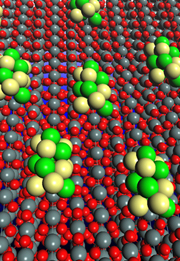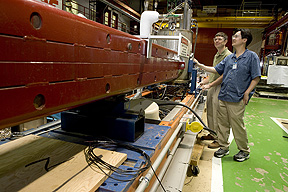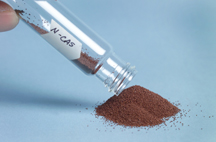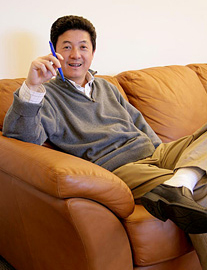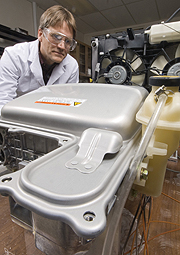| Research
|
Shou-Cheng Zhang says he likes looking for good analogies to explain science and make it accessible. And that's a very good thing, because as a condensed matter theorist with the Stanford Institute for Materials and Energy Science at DOE's SLAC National Accelerator Laboratory and Stanford University, Zhang has a lot of explaining to do. Zhang recently used the spin of electrons to predict a semi-conducting material that dissipates less energy, giving it powerful applications in the computing industry. When a solid transports current, says Zhang, on the atomic level it looks like a Berlin nightclub around 3:00 a.m. "It's totally disordered. You're the electron, trying to move from one side of the room to the other, but you keep bumping into people and losing energy." Zhang's goal is to get the electrons to dance more coherently. He imagines the interior of a solid as a dance floor, with some pairs of electrons spinning clockwise while moving clockwise around the room, and other couples spinning counterclockwise while moving counterclockwise. No one bumps into each other, so they don't dissipate energy. Part of this "dance," the electrons' movement, was previously understood. It's called the quantum Hall effect, and occurs when a solid is placed in a strong magnetic field. But by adding the spinning motion in his calculations, Zhang removed the theoretical need for a magnet. In a 2006 paper, he pointed to a real-world material—mercury telluride—in which this dancing pattern, known as the quantum spin Hall effect, could occur. One year later, collaborators at the University of Würzberg confirmed the theory experimentally. The discovery of this new state of matter was lauded by Science as a runner-up breakthrough of 2007. However, Zhang's material needs to be cooled to a few degrees Kelvin to work. So now Zhang is busy dreaming up the material that could exhibit the quantum spin Hall effect at room temperature. If he succeeds, the theoretical could meet the practical in a very powerful way. "There are physicists who dream things up, and others who make things happen," he says. "Even though we dreamers don't seem to do anything, we contribute in our way." Submitted by DOE's SLAC National Accelerator Laboratory |
|||||||||||||||||||||||||||
|
Check out the joint Fermilab/SLAC publication symmetry.
|
Advanced vehicles on verge of a market breakthrough
"About one-third of the incremental cost of hybrids is in its power electronics," said NREL senior engineer Ken Kelly. "We need to process that electricity in ways that are reliable and extend the range of the vehicle." The Toyota Prius hybrid system drive already works at 90 percent efficiency. But heat is its enemy; efficiency dips as the coolant temperature increases. If it could run cooler, it would run longer. And it could be manufactured using less expensive materials. Kelly's group is experimenting with heat exchangers made of different layers, including graphite and indium. "One third of your radiator's capacity is used to cool the vehicle's electronics," Kelly said. "People want to package things smaller and powerfully. That means there is more heat in a small space. So the challenge is growing to get heat from the device to the coolant." In a separate experiment, senior engineer Sreekant Narumanchi is developing an advanced gel to spread between power electronics components. Silicon chips typically rest on a metal base plate that conducts heat away from the chip. This heat transfer is aided by a very thin gel layer spread between the parts. The conventional gel's performance suffers under the high heat and pressure generated in a car engine. Narumanchi's new gels include metals, graphite and advanced ingredients such as carbon nanotubes. His equipment simulates years of high-temperature conditions and temperature cycling over weeks "Our target is a material that will perform for 15 years," he said. Submitted by DOE's National Renewable |


